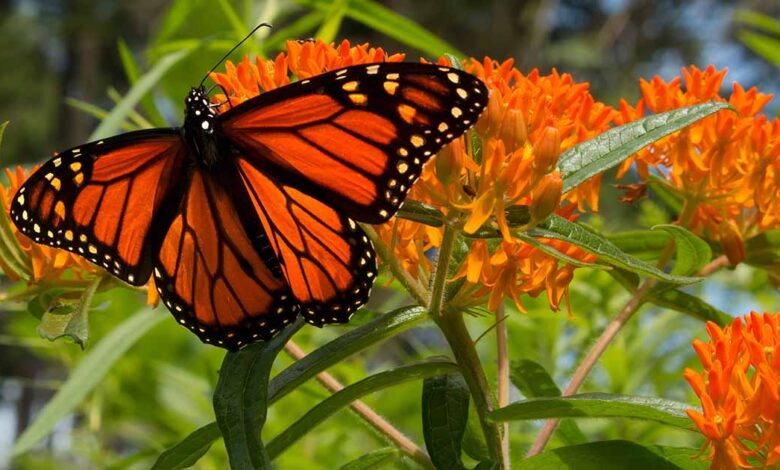
The monarch butterfly, with its distinctive orange and black wings, is a symbol of beauty and fragility in the natural world. Unfortunately, the population of monarchs has been declining, raising concerns among conservationists and nature enthusiasts. One crucial way individuals can contribute to monarch conservation efforts is by planting milkweed, the sole host plant for monarch caterpillars. In this comprehensive guide, we will explore the different types of milkweed that can be planted to support monarch butterflies and contribute to their survival.
Section 1: Understanding the Monarch Life Cycle
1.1 The Importance of Milkweed: Milkweed is not just any plant; it is the lifeline for monarch butterflies. Monarch caterpillars exclusively feed on milkweed, and by planting it, you provide a vital food source for these beautiful insects.
1.2 The Monarch’s Journey: Understanding the life cycle of monarch butterflies is crucial. From egg to caterpillar to chrysalis to adult butterfly, each stage relies on the availability of milkweed for sustenance and reproduction.
Section 2: Types of Milkweed
2.1 Common Milkweed (Asclepias syriaca): One of the most widespread varieties, common milkweed is known for its tall stems and large, round clusters of pinkish-purple flowers. It is a favorite among monarchs for laying eggs and provides ample nectar for adult butterflies.
2.2 Swamp Milkweed (Asclepias incarnata): Well-suited for wetter environments, swamp milkweed thrives in moist soil. Its pink to mauve-colored flowers attract not only monarchs but also a variety of pollinators, making it an excellent addition to any garden.
2.3 Butterfly Weed (Asclepias tuberosa): Known for its vibrant orange, red, or yellow flowers, butterfly weed is a visually striking milkweed variety. Its bright blooms attract both monarchs and a plethora of other pollinators, making it a popular choice for butterfly gardens.
2.4 Tropical Milkweed (Asclepias curassavica): Native to the Americas, tropical milkweed is a non-native species that has gained popularity due to its long blooming season. However, caution is needed, as it can disrupt monarch migration patterns in some regions.
Section 3: Planting and Caring for Milkweed
3.1 Planting Tips: When and where to plant milkweed are crucial considerations. Planting in the spring allows for optimal growth, and selecting a sunny location with well-drained soil provides an ideal environment for milkweed to thrive.
3.2 Maintenance: While milkweed is generally low-maintenance, regular monitoring for pests and diseases is essential. Trimming back spent flowers can encourage more blooms, providing a continuous food source for monarchs.
3.3 Creating Butterfly-Friendly Gardens: Enhance your garden’s appeal to monarchs by incorporating other nectar-rich plants. Include a variety of flowers that bloom at different times to ensure a constant supply of food for adult butterflies.
Section 4: Monarch Conservation Challenges and Solutions
4.1 Threats to Monarch Populations: Deforestation, climate change, and the use of herbicides pose significant threats to monarch butterflies. Understanding these challenges is crucial in formulating effective conservation strategies.
4.2 Citizen Science Initiatives: Engage in citizen science initiatives that contribute valuable data to monarch conservation efforts. Programs like Monarch Watch allow individuals to tag monarchs, providing insights into their migratory patterns.
4.3 Educating Others: Raise awareness about the importance of milkweed planting and monarch conservation. Schools, community groups, and nature centers can play a vital role in educating the public about these iconic butterflies.
Section 5: Success Stories and Inspirations
5.1 Community Monarch Gardens: Explore success stories of communities coming together to create monarch-friendly gardens. These initiatives not only benefit monarchs but also foster a sense of environmental stewardship among residents.
5.2 Monarch Waystations: Learn about the Monarch Waystation program, which encourages the creation of habitats that support monarchs during their migrations. Discover how individuals and organizations can certify their gardens as official waystations.
Section 6: Conclusion
In conclusion, planting the right kind of milkweed is a simple yet impactful way to contribute to monarch conservation. By understanding the different types of milkweed, the monarch life cycle, and the challenges these butterflies face, individuals can make informed choices in creating a welcoming habitat. Whether you have a small backyard or a community garden, every milkweed planted is a step towards ensuring the survival of the iconic monarch butterfly.



